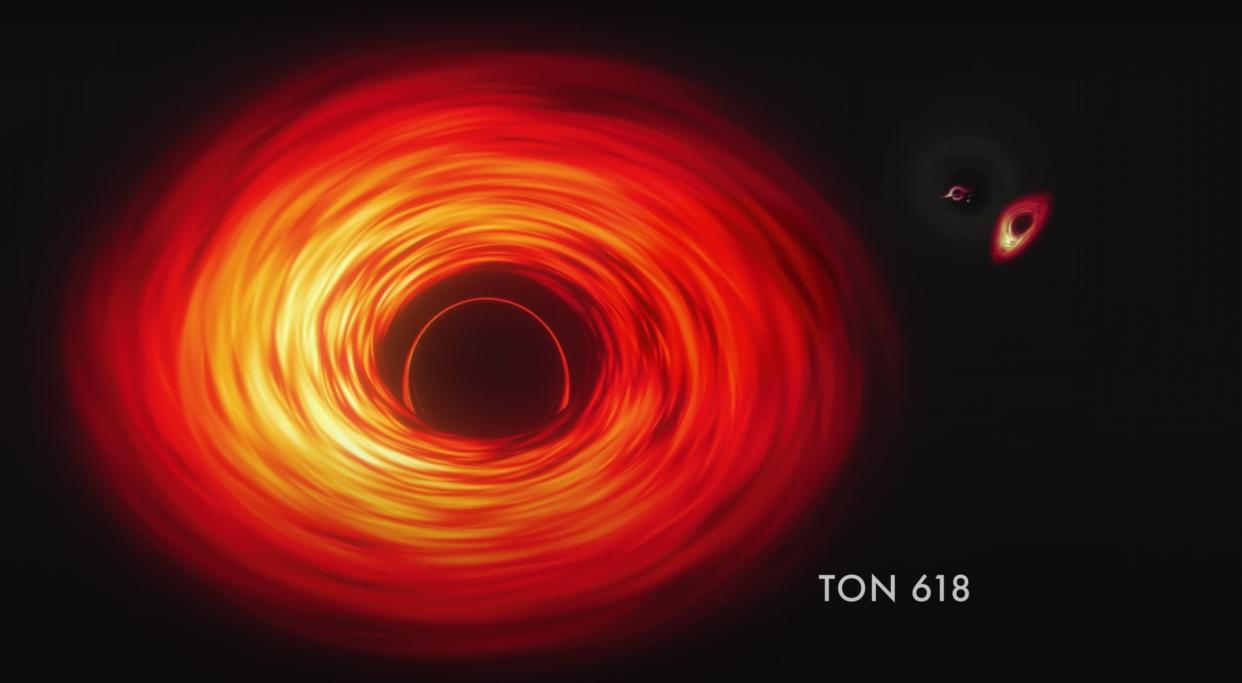Tour 10 mind-bending supermassive black holes in this NASA video

A new animation from NASA illustrates the tremendous scale of supermassive black holes, which are believed to dwell at the heart of most, if not all, large galaxies.
These cosmic titans have masses anywhere between 100,000 and tens of billions of times that of the sun. But astrophysicists aren't quite sure how supermassive black holes attain their incredible heft.
"Direct measurements, many made with the help of the Hubble Space Telescope, confirm the presence of more than 100 supermassive black holes," Jeremy Schnittman, a theorist at NASA's Goddard Space Flight Center in Greenbelt, Maryland, said in a statement. "How do they get so big? When galaxies collide, their central black holes eventually may merge together, too."
Related: Black holes: Everything you need to know
The new NASA video travels through 10 supermassive black holes of increasing mass, including the one at the heart of our galaxy, Sagittarius A* (Sgr A*), and the first black hole ever imaged by humanity, the black hole at the core of the galaxy Messier 87 (M87). The sizes of the supermassive black holes in the animation are scaled up based on the width of their "shadows."
All black holes have a spherical outer boundary called an event horizon, which is the point at which not even light can escape the black hole's tremendous gravitational pull. The diameter of the event horizon is determined by the mass of the black hole; more mass means a wider black hole. The shadow of the black hole is about twice the size of its event horizon, NASA officials said.
The animation begins at our sun, which is the most massive object in the solar system, accounting for 99% of its mass. Our view then pulls back to gradually reveal increasingly wider structures in the solar system, such as the orbits of planets like Mercury, Earth and Jupiter and the distance to features like the main asteroid belt and the Oort Cloud, a vast comet repository far from the sun. The animation compares these widths to supermassive black hole shadows of increasing size.
The first supermassive black hole featured is that of the dwarf galaxy J1601+3113, with a mass about 100,000 times that of the sun. This black hole's shadow is comparable to the width of the sun.
The animation also highlights Sgr A*, which has a mass 4.3 million times that of the sun and a shadow with a diameter around half the distance between Mercury and the sun. Pulling out further, the animation passes the two massive black holes located in the galaxy NGC 7727.
About 1,600 light-years separates these two black holes, which have masses 6 million and 150 million times that of the sun, respectively. The distance between the two behemoths is declining all the time, however, and astronomers estimate that, within 250 million years or so, the two black holes will merge, forming an even more massive daughter black hole.
Collisions like this could be the key to understanding how supermassive black holes grow. Such mergers cause ripples in space-time called gravitational waves, which detectors here on Earth such as the LIGO system have measured. And NASA is working toward a space-based gravitational wave detector called the Laser Interferometer Space Antenna (LISA), which could detect even more of these space-time ripples, helping us better understand these violent events.
Related: What are gravitational waves?
RELATED STORIES:
— Astronomers snap 1st-ever direct image of a black hole blasting out a powerful jet (photo, video)
— Tiny primordial black holes could have created their own Big Bang
From these two collision-bound black holes, the animation moves on to larger-scale objects that would no longer fit within our solar system, such as the supermassive black hole at the heart of M87. This object, known as M87*, has a mass of about 5.4 billion suns, researchers recently determined.
M87,* which was directly seen by the Event Horizon Telescope (EHT) in an image released to the public in 2019, has a shadow so wide it would take light two and a half days to traverse it, NASA officials said.
The video culminates at Tonantzintla 618 (Ton 618), which has a mass around 60 billion times that of the sun — the highest discovered to date. To put that into perspective: Ton 618 is around 15,000 times more massive than Sgr A* and is about six times more massive than every star in the Large Magellanic Cloud combined. (The LMC is a dwarf satellite galaxy of our own Milky Way.)
Ton 618 is located around 10 billion light-years from Earth and is so wide that it would take a beam of light several weeks to cross its shadow. The new animation lingers on the giant black hole for a few seconds before fading to black, giving viewers a chance to reckon with its mind-bending immensity.
Follow us on Twitter @Spacedotcom or on Facebook.


